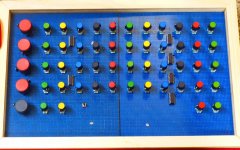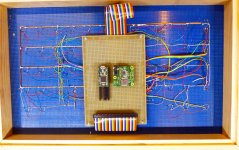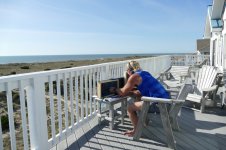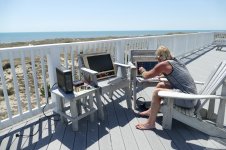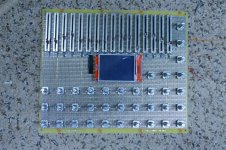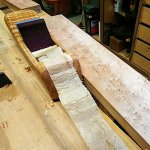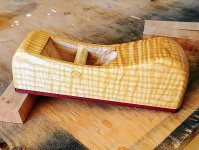I keep a running list of parts that I need. These little 1 Meg pots have vanished from Digikey and Mouser, so I rigged some standard pots into the Eurorack modules that I built a few months back. The picture shows how I did this on a Thomas Henry 2164 VCA / VCF module. There are several more unfinished modules here waiting for parts, time or both. There is also a new front panel for my MFOS Ultimate and Ultimate Expander synth.
I test fitted the goldmine pots into a Nonlinear Circuits DelayNoMore board, and ordered some extra. I have a Befaco Crush Delay board and panel set on order from Synthcube, but it is on backorder.
I test fitted the goldmine pots into a Nonlinear Circuits DelayNoMore board, and ordered some extra. I have a Befaco Crush Delay board and panel set on order from Synthcube, but it is on backorder.
Attachments
COOL!!The picture shows how I did this on a Thomas Henry 2164 VCA / VCF module. There are several more unfinished modules here waiting for parts, time or both. There is also a new front panel for my MFOS Ultimate and Ultimate Expander synth.
Check Tayda Electronics (Thailand) for odd and non-odd potentiometers.
.............
1900 litres of heating fuel. Price has come right down to £0.18/l and I think it will now hover around that price.
................................
I was wrong !!
The oil price is now £0.26/l.
Saved myself £150.
.
......
SSD is going to blow your mind, Andy!
You were right about that!!
Boot up is almost instantaneous.
It's a pity that I cannot increase the RAM.
It's at the maximum of 12Gb.......20Gb would be nice.
Andy
some items for my turntable
Hello,
For a long time i had this project in the attic so to say.
A week or two ago i put the turntable where i wanted it to be .
It is a German brand named Scheu which i gave something like my own signature using a pom material base also filled with lead shot like the Scheu itself.
I found the center of gravity by letting it '' float '' on a bolt after that i made 3 big circular holes ( at the right distance from the center) in the lower part of the base to cover the upper part of the Townshend seismic pods. It appeared however that the weight was to close to the maximum weight so hard to make the pods actually work. So i started looking for the model that can support a bigger weight. It is nowhere in stock. The Townshend company is in a kind of lockdown for most of the time. Asking about delivery time almost feels like cursing them.
Because with the new pods the weight is on the lower side i have been thinking about adding some weight to the base in such a way that the weight will be in the middle of min and max weight.
The center of gravity is not in the same position as the spindle because i had limited space for the machine . On the left corner in the back there will be the motor and in the right corner in the back will be the arm. The arm base i made from pom filled with lead shot.
My idea was to take a big diameter ( 2 to 3 inches diameter) pvc water hose. Make a donut shape so it can be put around the round Scheu base. Fill this hose with lead shot. The pvc is rather thin because i want the lead to be in touch with the base. I also ordered some large diameter heat shrink to hide the blue hose and maybe use in the area that is wing shaped to support the arm base. Can use it there to reduce the diameter.
I expect to be able to '' drape '' the donut in such a way that all 3 pods are equally loaded.
Hope to get the hose and heat shrink tomorrow. 20 kilogrammes (44lbs) lead shot already in the house.
Delivery sometimes a bit delayed
But i dont understand the companies that could make nice sales or find new customers are now hiding behind corona and let their service levels go down the drain.
Finally found a company that could deliver the pods but Townshend company was not there to take his order yesterday. This morning i received an invoice for some other parts and a single pod while i need 3. I mentioned before i need 3 and they didnt correct it so now waiting again for them to send a new invoice.
I think it is a shame. I remember ordering in Japan with fax machine and international money order going quicker than just trying to get what you want.
Greetings, eduard
Hello,
For a long time i had this project in the attic so to say.
A week or two ago i put the turntable where i wanted it to be .
It is a German brand named Scheu which i gave something like my own signature using a pom material base also filled with lead shot like the Scheu itself.
I found the center of gravity by letting it '' float '' on a bolt after that i made 3 big circular holes ( at the right distance from the center) in the lower part of the base to cover the upper part of the Townshend seismic pods. It appeared however that the weight was to close to the maximum weight so hard to make the pods actually work. So i started looking for the model that can support a bigger weight. It is nowhere in stock. The Townshend company is in a kind of lockdown for most of the time. Asking about delivery time almost feels like cursing them.
Because with the new pods the weight is on the lower side i have been thinking about adding some weight to the base in such a way that the weight will be in the middle of min and max weight.
The center of gravity is not in the same position as the spindle because i had limited space for the machine . On the left corner in the back there will be the motor and in the right corner in the back will be the arm. The arm base i made from pom filled with lead shot.
My idea was to take a big diameter ( 2 to 3 inches diameter) pvc water hose. Make a donut shape so it can be put around the round Scheu base. Fill this hose with lead shot. The pvc is rather thin because i want the lead to be in touch with the base. I also ordered some large diameter heat shrink to hide the blue hose and maybe use in the area that is wing shaped to support the arm base. Can use it there to reduce the diameter.
I expect to be able to '' drape '' the donut in such a way that all 3 pods are equally loaded.
Hope to get the hose and heat shrink tomorrow. 20 kilogrammes (44lbs) lead shot already in the house.
Delivery sometimes a bit delayed
But i dont understand the companies that could make nice sales or find new customers are now hiding behind corona and let their service levels go down the drain.
Finally found a company that could deliver the pods but Townshend company was not there to take his order yesterday. This morning i received an invoice for some other parts and a single pod while i need 3. I mentioned before i need 3 and they didnt correct it so now waiting again for them to send a new invoice.
I think it is a shame. I remember ordering in Japan with fax machine and international money order going quicker than just trying to get what you want.
Greetings, eduard
Attachments
-
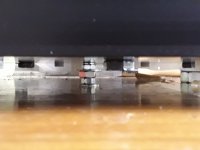 20181022_150713.jpg821.3 KB · Views: 98
20181022_150713.jpg821.3 KB · Views: 98 -
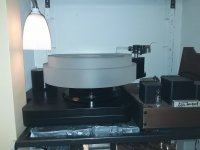 20200604_221810.jpg890.5 KB · Views: 102
20200604_221810.jpg890.5 KB · Views: 102 -
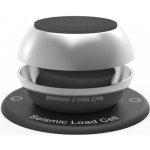 townshend-seismic-isolation-pod-computer-turntable-amplifier-speakers.jpg12.2 KB · Views: 44
townshend-seismic-isolation-pod-computer-turntable-amplifier-speakers.jpg12.2 KB · Views: 44 -
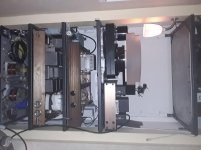 20200604_221842.jpg238.2 KB · Views: 48
20200604_221842.jpg238.2 KB · Views: 48 -
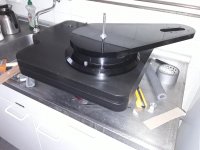 pom plus Scheu console.jpg103.5 KB · Views: 49
pom plus Scheu console.jpg103.5 KB · Views: 49 -
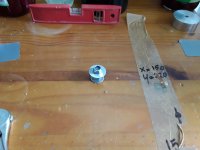 20181022_124839.jpg948.2 KB · Views: 44
20181022_124839.jpg948.2 KB · Views: 44 -
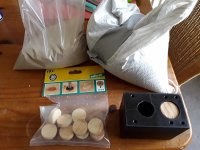 arm support pom en lood.jpg108.1 KB · Views: 39
arm support pom en lood.jpg108.1 KB · Views: 39
Looks like the tyke is headed for the tweeter. Ask Dr google "tweeter dent repair"


I don't dare to hook it up to my sweet little audiolabs
A suscription to Electronics World Magazine, that reminds me, I have to renew my AudioXpress suscription...
Hello,
Is there ANY magazine available nowadays that comes close to Sound Practices or L'audiophile ( from France) . The latter is surely number one. There is Radio MJ in Japan but very heard to read.
Greetings, Eduard
Hello,
Is there ANY magazine available nowadays that comes close to Sound Practices or L'audiophile ( from France) . The latter is surely number one. There is Radio MJ in Japan but very heard to read.
Greetings, Eduard
AudioXpress is the only magazine that I know of that still features audio electronics, the rest of the magazines are for the non-DIY audio enthusiasts, however AudioXpress is not 100% audio electronics, sadly there is no magazine today that is entirely focused on audio electronics, Jan Didden's Linear Audio was the exception but it ended around 3 years ago.
The late 90s to early 2000s volumes of Electronics World are great since there is a good amount of audio in it (you can check them out here: WIRELESS WORLD: UK technical magazine 1913-2005), nowadays the magazine is 99% embedded systems, MCUs, FPGAs, etc.. with the ocassional audio article.
the magazine is 99% embedded systems, MCUs, FPGAs, etc..
This is one of the last DIY electronics strongholds, since the barrier to entry is small in terms of cost and knowledge required.
I have been tinkering with DIY computer stuff since I first built the SWTPC (of Tiger amps fame) MC6800 computer system in 1975. Back then I could get a really ugly sounding monophonic synthesizer sound out of a parallel port chip. I have been tinkering with computer music making ever since.
I discovered the Teensy MCU board and its drag and drop audio library about 3 1/2 years ago. This lets you "design" audio devices with "connect the dots" ease. So what did the Dumm Blonde One do? He wired up a box full of pots, several encoders and a few chips to one of these Teensy boards and made a music synthesizer. Here is an early dem before it ever had a keyboard.
YouTube
It has gone through several iterations to get where it is now, and was being modified again, when I got an email from PJRC, the maker of the Teensy boards. It seems that they had offered me a free sample of their newest board, but I didn't see the forum post with my name buried in the middle of it. Did I want a free board? UH, YEAH!
Teensy 4.1 Beta Test
So I put the old synth back together as is, (pictures) since it works just fine, and decided to make something cool with the new T4.1 board.
What do I make...….Well, I'm not exactly sure, but I'm making it up as I go along, sorta like the last one. I dig through my boxes of "stuff" and find some cool slide pots with LED's on them....they're cool, so they go in. I have LOTS of encoders, so we need some of them. I have a big piece of perf board with solder pads, it has been used twice, but is in the "box of shattered dreams" so it gets recycled again....I see a small color touch screen display, so in it goes...…..I still don't know what this will be yet, but with 36 knobs, 16 slide pots, a touch screen display, 8 X 44/16 DAC's, 6 X 44/16 ADC's, and a 32 bit processor running at 600 MHz (overclockable to 1 GHz), it can be anything it wants to be (picture)...….probably a MIDI sequencer since I could use one.
Now, how do I connect 36 rotary encoders to a processor chip. My first thought was to multiplex them all since you only have two hands so only two will be turned at once, and the chip can sample much faster than the knobs can be turned, but some Google searching led me to some new PIC chips that cost less than the multiplexer chips, and could do all sorts of neat other stuff too.
There are PIC chips that have up to three NCO's inside. A NCO is a Numerically Controlled Oscillator, signal generation technology with microhertz resolution usually found in pricey DDS chips. These chips have the ability to modulate one waveform with another. There are all sorts of timing features built in.....but the reason to Paypal some $$$ to Digikey turned out to be the under $2 per chip price and the availability in breadboard friendly DIP packages. So I got 5 X each of 3 different cheap chips, and a programmer.
I guess my new board will be a synthesizer.....or a sequencer.....or a mixing board....or......Wait, it can be ALL of these....with a guitar jack too!
Attachments
I forgot to mention the neat little "Curiosity Nano" board that Microchip makes to play with these new chips. For $15, I also got one of these to play with.
PIC18F57Q43 Curiosity Nano Evaluation Kit
PIC18F57Q43 Curiosity Nano Evaluation Kit
This is one of the last DIY electronics strongholds, since the barrier to entry is small in terms of cost and knowledge required.
I have been tinkering with DIY computer stuff since I first built the SWTPC (of Tiger amps fame) MC6800 computer system in 1975. Back then I could get a really ugly sounding monophonic synthesizer sound out of a parallel port chip. I have been tinkering with computer music making ever since.
I discovered the Teensy MCU board and its drag and drop audio library about 3 1/2 years ago. This lets you "design" audio devices with "connect the dots" ease. So what did the Dumm Blonde One do? He wired up a box full of pots, several encoders and a few chips to one of these Teensy boards and made a music synthesizer. Here is an early dem before it ever had a keyboard.
YouTube
It has gone through several iterations to get where it is now, and was being modified again, when I got an email from PJRC, the maker of the Teensy boards. It seems that they had offered me a free sample of their newest board, but I didn't see the forum post with my name buried in the middle of it. Did I want a free board? UH, YEAH!
Teensy 4.1 Beta Test
So I put the old synth back together as is, (pictures) since it works just fine, and decided to make something cool with the new T4.1 board.
What do I make...….Well, I'm not exactly sure, but I'm making it up as I go along, sorta like the last one. I dig through my boxes of "stuff" and find some cool slide pots with LED's on them....they're cool, so they go in. I have LOTS of encoders, so we need some of them. I have a big piece of perf board with solder pads, it has been used twice, but is in the "box of shattered dreams" so it gets recycled again....I see a small color touch screen display, so in it goes...…..I still don't know what this will be yet, but with 36 knobs, 16 slide pots, a touch screen display, 8 X 44/16 DAC's, 6 X 44/16 ADC's, and a 32 bit processor running at 600 MHz (overclockable to 1 GHz), it can be anything it wants to be (picture)...….probably a MIDI sequencer since I could use one.
Now, how do I connect 36 rotary encoders to a processor chip. My first thought was to multiplex them all since you only have two hands so only two will be turned at once, and the chip can sample much faster than the knobs can be turned, but some Google searching led me to some new PIC chips that cost less than the multiplexer chips, and could do all sorts of neat other stuff too.
There are PIC chips that have up to three NCO's inside. A NCO is a Numerically Controlled Oscillator, signal generation technology with microhertz resolution usually found in pricey DDS chips. These chips have the ability to modulate one waveform with another. There are all sorts of timing features built in.....but the reason to Paypal some $$$ to Digikey turned out to be the under $2 per chip price and the availability in breadboard friendly DIP packages. So I got 5 X each of 3 different cheap chips, and a programmer.
I guess my new board will be a synthesizer.....or a sequencer.....or a mixing board....or......Wait, it can be ALL of these....with a guitar jack too!
Nice synth and great looking house by the beach!
Those Teensy MCU boards look interesting, they are 32bit, do you use the Arduino IDE to program them? Arduino makes things so easy, when I had to program a 8051 MCU in assembler back in college, doing the most basic stuff was complicated, then I moved to PICs and AVRs, easier, but nothing like the Arduino.
Last edited:
Member
Joined 2009
Paid Member
This is one of the last DIY electronics strongholds, since the barrier to entry is small in terms of cost and knowledge required.
is this where you live? it looks fantastic, sun, water, tinkering.....
- Home
- Member Areas
- The Lounge
- And what did we buy today?
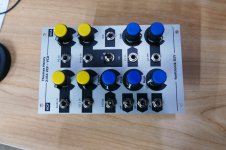
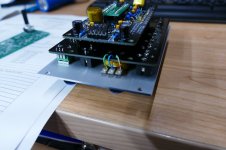
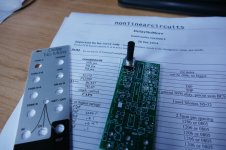
 (couldn't find a dog emoji)
(couldn't find a dog emoji)